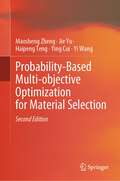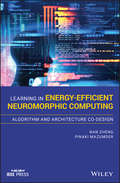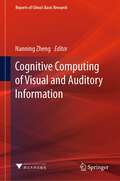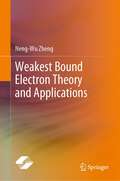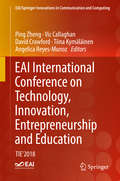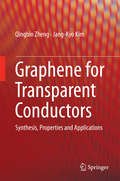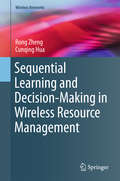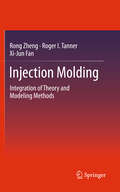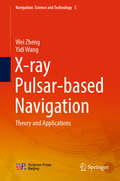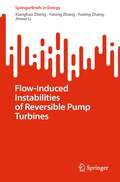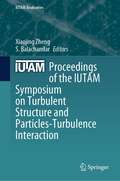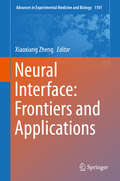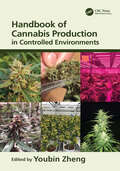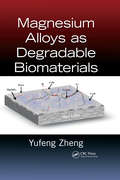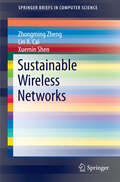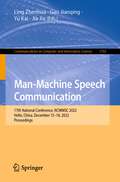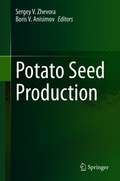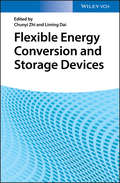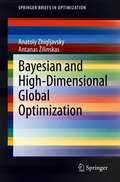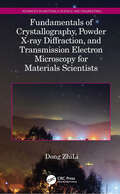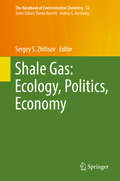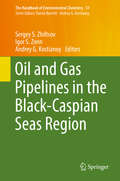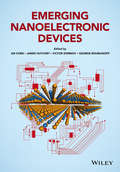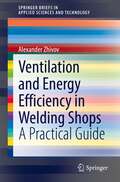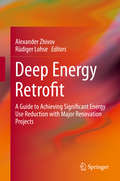- Table View
- List View
Probability-Based Multi-objective Optimization for Material Selection
by Maosheng Zheng Jie Yu Haipeng Teng Ying Cui Yi WangThe second edition of this book illuminates the fundamental principle and applications of probability-based multi-objective optimization for material selection in viewpoint of system theory, in which a brand new concept of preferable probability and its assessment as well as other treatments are introduced by authors for the first time. Hybrids of the new approach with experimental design methodologies (response surface methodology, orthogonal experimental design, and uniform experimental design) are all performed; robustness assessment and performance utility with desirable value are included; discretization treatment in the evaluation is presented; fuzzy-based approach and cluster analysis are involved; applications in portfolio investment and shortest path problem are concerned as well. The authors wish this work will cast a brick to attract jade and would make its contributions to relevant fields as a paving stone. It is designed to be used as a textbook for postgraduate and advanced undergraduate students in relevant majors, while also serving as a valuable reference book for scientists and engineers involved in related fields.
Learning in Energy-Efficient Neuromorphic Computing: Algorithm And Architecture Co-design (Wiley - IEEE)
by Nan Zheng Pinaki MazumderExplains current co-design and co-optimization methodologies for building hardware neural networks and algorithms for machine learning applications This book focuses on how to build energy-efficient hardware for neural networks with learning capabilities—and provides co-design and co-optimization methodologies for building hardware neural networks that can learn. Presenting a complete picture from high-level algorithm to low-level implementation details, Learning in Energy-Efficient Neuromorphic Computing: Algorithm and Architecture Co-Design also covers many fundamentals and essentials in neural networks (e.g., deep learning), as well as hardware implementation of neural networks. The book begins with an overview of neural networks. It then discusses algorithms for utilizing and training rate-based artificial neural networks. Next comes an introduction to various options for executing neural networks, ranging from general-purpose processors to specialized hardware, from digital accelerator to analog accelerator. A design example on building energy-efficient accelerator for adaptive dynamic programming with neural networks is also presented. An examination of fundamental concepts and popular learning algorithms for spiking neural networks follows that, along with a look at the hardware for spiking neural networks. Then comes a chapter offering readers three design examples (two of which are based on conventional CMOS, and one on emerging nanotechnology) to implement the learning algorithm found in the previous chapter. The book concludes with an outlook on the future of neural network hardware. Includes cross-layer survey of hardware accelerators for neuromorphic algorithms Covers the co-design of architecture and algorithms with emerging devices for much-improved computing efficiency Focuses on the co-design of algorithms and hardware, which is especially critical for using emerging devices, such as traditional memristors or diffusive memristors, for neuromorphic computing Learning in Energy-Efficient Neuromorphic Computing: Algorithm and Architecture Co-Design is an ideal resource for researchers, scientists, software engineers, and hardware engineers dealing with the ever-increasing requirement on power consumption and response time. It is also excellent for teaching and training undergraduate and graduate students about the latest generation neural networks with powerful learning capabilities.
Cognitive Computing of Visual and Auditory Information (Reports of China’s Basic Research)
by Nanning ZhengThis book discusses fruitful achievements in basic cognitive theories, processing technologies of visual and auditory information and research platforms. This book also can provide strong support for the research and development of artificial intelligence of major national projects, playing important roles in national application systems such as unmanned systems and smart cities. In addition, it has laid a solid foundation for the development of artificial intelligence in China. Intended for researchers who have been following the evolution of and trends in the artificial intelligence, the book is also a valuable reference resource for practitioners and scholars at various levels and in various fields.
Weakest Bound Electron Theory and Applications
by Neng-Wu ZhengThis monograph describes the new quantum theory called the weakest bound electron theory (WBE theory) proposed by Prof. Neng-Wu Zheng and its applications. It starts with the fundamentals of quantum mechanics and then illustrates the key points of WBE theory and the mathematical expressions of WBE theory. Finally, it presents a wide range of applications of WBE theory to the chemical and physical properties of atoms and molecules, including energy levels, transition properties, the difference law of ionization energies etc. It appeals to a broad readership, particularly researchers and academics in chemistry, physics, and materials science.
EAI International Conference on Technology, Innovation, Entrepreneurship and Education: TIE'2018 (Lecture Notes in Electrical Engineering #532)
by Ping Zheng Vic Callaghan David Crawford Tiina Kymäläinen Angelica Reyes-MunozThis book presents the proceedings of the 2nd EAI International Conference on Technology, Innovation, Entrepreneurship and Education (TIE' 2018), which took place at Ravensbourne University London, London, UK, on September 4, 2018. The central theme of the conference is emerging technologies in relation to business, education, social and political needs that make modern society flourish. The proceedings feature papers from a cross-disciplinary audience that explore the process of creativity and innovation. The goal is that the various disciplines can learn from each other and see how they might benefit from the cross-fertilization of practices.
Graphene for Transparent Conductors
by Qingbin Zheng Jang-Kyo KimThis book provides a systematic presentation of the principles and practices behind the synthesis and functionalization of graphene and grapheme oxide (GO), as well as the fabrication techniques for transparent conductors from these materials. Transparent conductors are used in a wide variety of photoelectronic and photovoltaic devices, such as liquid crystal displays (LCDs), solar cells, optical communication devices, and solid-state lighting. Thin films made from indium tin oxide (ITO) have thus far been the dominant source of transparent conductors, and now account for 50% of indium consumption. However, the price of Indium has increased 1000% in the last 10 years. Graphene, a two-dimensional monolayer of sp2-bonded carbon atoms, has attracted significant interest because of its unique transport properties. Because of their high optical transmittance and electrical conductivity, thin film electrodes made from graphene nanosheets have been considered an ideal candidate to replace expensive ITO films. Graphene for Transparent Conductors offers a systematic presentation of the principles, theories and technical practices behind the structure-property relationship of the thin films, which are the key to the successful development of high-performance transparent conductors. At the same time, the unique perspectives provided in the applications of graphene and GO as transparent conductors will serve as a general guide to the design and fabrication of thin film materials for specific applications.
Sequential Learning and Decision-Making in Wireless Resource Management
by Rong Zheng Cunqing HuaThis book lays out the theoretical foundation of the so-called multi-armed bandit (MAB) problems and puts it in the context of resource management in wireless networks. Part I of the book presents the formulations, algorithms and performance of three forms of MAB problems, namely, stochastic, Markov and adversarial. Covering all three forms of MAB problems makes this book unique in the field. Part II of the book provides detailed discussions of representative applications of the sequential learning framework in cognitive radio networks, wireless LANs and wireless mesh networks. Both individuals in industry and those in the wireless research community will benefit from this comprehensive and timely treatment of these topics. Advanced-level students studying communications engineering and networks will also find the content valuable and accessible.
Injection Molding
by Rong Zheng Roger I. Tanner Xi-Jun FanThis book covers fundamental principles and numerical methods relevant to the modeling of the injection molding process. As injection molding processing is related to rheology, mechanical and chemical engineering, polymer science and computational methods, and is a rapidly growing field, the book provides a multidisciplinary and comprehensive introduction to the subjects required for an understanding of the complex process. It addresses the up-to-date status of fundamental understanding and simulation technologies, without losing sight of still useful classical approaches. The main chapters of the book are devoted to the currently active fields of flow-induced crystallization and orientation evolution of fiber suspensions, respectively, followed by detailed discussion of their effects on mechanical property, shrinkage and warpage of injection-molded products. The level of the proposed book will be suitable for interested scientists, R&D engineers, application engineers, and graduate students in engineering.
X-ray Pulsar-based Navigation: Theory and Applications (Navigation: Science and Technology #5)
by Wei Zheng Yidi WangThis book discusses autonomous spacecraft navigation based on X-ray pulsars, analyzing how to process X-ray pulsar signals, how to simulate them, and how to estimate the pulse’s time of arrival based on epoch folding. In turn, the book presents a range of X-ray pulsar-based spacecraft positioning/time-keeping/attitude determination methods. It also describes the error transmission mechanism of the X-ray pulsar-based navigation system and its corresponding compensation methods. Further, the book introduces readers to navigation based on multiple measurement information fusion, such as X-ray pulsar/traditional celestial body integrated navigation and X-ray pulsar/INS integrated navigation. As such, it offers readers extensive information on both the theory and applications of X-ray pulsar-based navigation, and reflects the latest developments in China and abroad.
Flow-Induced Instabilities of Reversible Pump Turbines (SpringerBriefs in Energy)
by Xianghao Zheng Yuning Zhang Jinwei LiThis brief provides a comprehensive introduction on the flow-induced instabilities (e.g., the pressure fluctuations and the vibrations) of the reversible pump turbines (RPTs) in the pumped hydro energy storage power stations (PHSEPSs) in China based on long-term field tests. The pressure fluctuations and the vibrations of several RPTs in China under different operational conditions are analysed in detail to reveal their generation mechanisms and propagation characteristics. The book presents advanced signal analysis and processing methods which are used for obtaining the time-frequency information and for finding the internal correlations between several types of signals. Advanced artificial intelligence algorithms are adopted for understanding the effective fault diagnosis and the identification of different flow patterns. The book overviews the fundamentals of the RPTs and the signal analysis methods, while it demonstrates that the analysis results of the pressure fluctuation and vibration data may be employed for the calibration of numerical simulations and the comparisons of model tests. It is primarily targeted to researchers and engineers working on the fields of condition monitoring and fault diagnosis of hydraulic machineries.
Proceedings of the IUTAM Symposium on Turbulent Structure and Particles-Turbulence Interaction (IUTAM Bookseries #41)
by Xiaojing Zheng S. BalachandarThis book presents the proceedings of the 'IUTAM Symposium on Turbulent Structure and Particles' held in 2023. It provides a comprehensive overview of the latest research and developments in the field of turbulent dispersed multiphase flows. The book features contributions from experts in academia and industry, covering a range of topics including droplet and pollutant dispersion, sand/dust storms, sediment transport in water or air flows, fluidized beds, bubbly flows and more. The content is a valuable reference for researchers, engineers, and students who are interested in understanding the complex behavior of multiphase flows in different natural and industrial environments.
Neural Interface: Frontiers and Applications (Advances in Experimental Medicine and Biology #1101)
by Xiaoxiang ZhengThis book focuses on the frontiers of neural interface technology, including hardware, software, neural decoding and encoding, control systems, and system integration. It also discusses applications for neuroprosthetics, neural diseases and neurorobotics, and the toolkits for basic neuroscience. A neural interface establishes a direct communication channel with the central or peripheral nervous system (CNS or PNS), and enables the nervous system to interact directly with the external devices. Recent advances in neuroscience and engineering are speeding up neural interface technology, paving the way for assisting, augmenting, repairing or restoring sensorimotor and other cognitive functions impaired due to neurological disease or trauma, and so improving the quality of life of those affected. Neural interfaces are now being explored in applications as diverse as rehabilitation, accessibility, gaming, education, recreation, robotics and human enhancement. Neural interfaces also represent a powerful tool to address fundamental questions in neuroscience. Recent decades have witnessed tremendous advances in the field, with a huge impact not only in the development of neuroprosthetics, but also in our basic understanding of brain function. Neural interface technology can be seen as a bridge across the traditional engineering and basic neuroscience. This book provides researchers, graduate and upper undergraduate students from a wide range of disciplines with a cutting-edge and comprehensive summary of neural interface engineering research.
Handbook of Cannabis Production in Controlled Environments
by Youbin ZhengFor thousands of years, Cannabis sativa, commonly called cannabis or marijuana, has been used for many different purposes. Due to its enormous medicinal values, increasing numbers of countries and regions have started to legalise the cultivation of this plant. When grown commercially, cannabis is most often produced in controlled environments including greenhouse and indoor growing rooms, to ensure consistent growth and high quality. Even for field production, propagation is frequently conducted in controlled environments. Commercial operations and individual growers who cultivate cannabis for personal consumption, require scientific information on how to cultivate cannabis most effectively and efficiently. To meet these needs, scientists have been conducting research on how to optimize cannabis cultivation both in small and large scales. Handbook of Cannabis Production in Controlled Environments is the result of collaborations between some leading cannabis scientists and highly experienced practitioners. Featuring full-color illustrations and photographs throughout, this book covers a broad range of topics include cannabis biology; science and techniques for breeding and propagation; management and optimization of both aerial and rootzone environments; plant nutrition and nutrient disorder diagnosis; crop training and pest management; harvesting and post-harvest processing. Along with the basic aspects of controlled environment cannabis production, this book summarises developments in these areas that may challenge old beliefs and improve production. Led by Editor, Youbin Zheng, President of the Canadian Society for Horticultural Science/La Société Canadienne de Science Horticole, this book is a practical guide for cultivators, consultants, and researchers; a reference for students; and an information source for individuals who grow cannabis for personal consumption.
Magnesium Alloys as Degradable Biomaterials
by Yufeng ZhengMagnesium Alloys as Degradable Biomaterials provides a comprehensive review of the biomedical applications of biodegradable magnesium and its alloys. Magnesium has seen increasing use in orthopedic and cardiovascular applications over the last decade, particularly for coronary stents and bone implants.The book discusses the basic concepts of biodeg
Sustainable Wireless Networks
by Zhongming Zheng Lin X. Cai Xuemin ShenThis brief focuses on network planning and resource allocation by jointly considering cost and energy sustainability in wireless networks with sustainable energy. The characteristics of green energy and investigating existing energy-efficient green approaches for wireless networks with sustainable energy is covered in the first part of this brief. The book then addresses the random availability and capacity of the energy supply. The authors explore how to maximize the energy sustainability of the network and minimize the failure probability that the mesh access points (APs) could deplete their energy and put the network out of service due to the unreliable energy supply. This brief also studies network resource management issues in green wireless networks to minimize cost. It jointly considers the relay node (RN) placement and sub-carrier allocation (RNP-SA) issues in wireless networks with sustainable energy, and then formulates the problem into a mixed integer non-linear programming problem. Concise and informative, this brief is a useful resource for professionals or researchers studying wireless networks, communication networks, and energy efficiency. Advanced-level students interested in energy technology or communications engineering will also find the material valuable.
Man-Machine Speech Communication: 17th National Conference, NCMMSC 2022, Hefei, China, December 15–18, 2022, Proceedings (Communications in Computer and Information Science #1765)
by Ling Zhenhua Gao Jianqing Yu Kai Jia JiaThis book constitutes the refereed proceedings of the 17th National Conference on Man–Machine Speech Communication, NCMMSC 2022, held in China, in December 2022.The 21 full papers and 7 short papers included in this book were carefully reviewed and selected from 108 submissions. They were organized in topical sections as follows: MCPN: A Multiple Cross-Perception Network for Real-Time Emotion Recognition in Conversation.- Baby Cry Recognition Based on Acoustic Segment Model, MnTTS2 An Open-Source Multi-Speaker Mongolian Text-to-Speech Synthesis Dataset.
Potato Seed Production
by Sergey V. Zhevora Boris V. AnisimovThis book comprises the best potato seed production practices and includes details on potato cultivation, classification, and the main structural elements of the successive stages of potato seed production. It presents potato varieties from Russian originators, describes modern technologies involved in the process of potato seed production, and presents special aspects of phytosanitary and process regulations for the cultivation of high-quality potato seed.Additionally, the authors illustrate the statutory regulation of salable quality of potato seed: purity of variety, diseases, pests, and defects. The authors identify Russian quality control methods and certification of potato seed, and consider the packaging and labeling of potato seed that is held for sale. Finally, the authors also clarify the features of foreign potato seed certification systems.
Flexible Energy Conversion and Storage Devices
by Chunyi Zhi Liming DaiReviewing recent progress in flexible energy conversion and storage devices, this highly relevant book introduces not only the basic principles and strategies to make a device flexible, but also the applicable materials and technologies. Adopting an application-oriented approach throughout, the text discusses perspectives for different devices, such as batteries, supercapacitors, solar cells and fuel cells, covering such technologies as polymers, carbon materials, nanotechnologies and textile technologies.
Bayesian and High-Dimensional Global Optimization (SpringerBriefs in Optimization)
by Anatoly Zhigljavsky Antanas ŽilinskasAccessible to a variety of readers, this book is of interest to specialists, graduate students and researchers in mathematics, optimization, computer science, operations research, management science, engineering and other applied areas interested in solving optimization problems. Basic principles, potential and boundaries of applicability of stochastic global optimization techniques are examined in this book. A variety of issues that face specialists in global optimization are explored, such as multidimensional spaces which are frequently ignored by researchers. The importance of precise interpretation of the mathematical results in assessments of optimization methods is demonstrated through examples of convergence in probability of random search. Methodological issues concerning construction and applicability of stochastic global optimization methods are discussed, including the one-step optimal average improvement method based on a statistical model of the objective function. A significant portion of this book is devoted to an analysis of high-dimensional global optimization problems and the so-called ‘curse of dimensionality’. An examination of the three different classes of high-dimensional optimization problems, the geometry of high-dimensional balls and cubes, very slow convergence of global random search algorithms in large-dimensional problems , and poor uniformity of the uniformly distributed sequences of points are included in this book.
Fundamentals of Crystallography, Powder X-ray Diffraction, and Transmission Electron Microscopy for Materials Scientists (Advances in Materials Science and Engineering)
by Dong ZhiLiThe structure–property relationship is a key topic in materials science and engineering. To understand why a material displays certain behaviors, the first step is to resolve its crystal structure and reveal its structure characteristics. Fundamentals of Crystallography, Powder X-ray Diffraction, and Transmission Electron Microscopy for Materials Scientists equips readers with an in-depth understanding of using powder x-ray diffraction and transmission electron microscopy for the analysis of crystal structures. Introduces fundamentals of crystallography Covers XRD of materials, including geometry and intensity of diffracted x-ray beams and experimental methods Describes TEM of materials and includes atomic scattering factors, electron diffraction, and diffraction and phase contrasts Discusses applications of HRTEM in materials research Explains concepts used in XRD and TEM lab training Based on the author’s course lecture notes, this text guides materials science and engineering students with minimal reliance on advanced mathematics. It will also appeal to a broad spectrum of readers, including researchers and professionals working in the disciplines of materials science and engineering, applied physics, and chemical engineering.
Shale Gas: Ecology, Politics, Economy
by Sergey S. ZhiltsovThis book highlights various aspects of shale gas production and discusses the associated problems, which have greatly influenced the current situation on the global gas market. It focuses on issues such as production technologies, environmental protection, and the impacts of shale gas production on human beings. Further, it investigates the role of shale gas in the development and implementation of foreign policy of many nations that welcomed the possibility to produce this hydrocarbon in their own countries. Taking into consideration the information published by world energy research centers, the prospects of shale gas production in different regions of the world are examined in detail. Given its coverage and scope, the book will greatly benefit specialists in the areas of hydrocarbon production, international relations and foreign policy, world economics and technologies, ecology and environmental protection.
Oil and Gas Pipelines in the Black-Caspian Seas Region
by Sergey S. Zhiltsov Igor S. Zonn Andrey G. KostianoyThis book concisely describes the architecture of the oil and gas pipelines in the Black-Caspian Seas Region and analyzes the status quo and perspectives of oil and gas production in this region. The authors present numerous projects, each of which has made a substantial contribution to the development of pipeline transport and transit in this part of the world, and discuss them in detail. The topics covered include: the region's geographic characteristics; the region's hydrocarbon potential; Russian and EU policy on pipeline transport; Kazakhstan's pipeline policy; Chinese pipeline projects; the Bulgarian gas transmission system; environmental risks in the production and transportation of hydrocarbons; satellite monitoring; and subsea leak detection. This volume offers a valuable resource for politicians, specialists in the oil and gas business, decision-makers, and environmentalists alike.
Emerging Nanoelectronic Devices
by Victor Zhirnov James Hutchby George Bourianoff An ChenEmerging Nanoelectronic Devices focuses on the future direction of semiconductor and emerging nanoscale device technology. As the dimensional scaling of CMOS approaches its limits, alternate information processing devices and microarchitectures are being explored to sustain increasing functionality at decreasing cost into the indefinite future. This is driving new paradigms of information processing enabled by innovative new devices, circuits, and architectures, necessary to support an increasingly interconnected world through a rapidly evolving internet. This original title provides a fresh perspective on emerging research devices in 26 up to date chapters written by the leading researchers in their respective areas. It supplements and extends the work performed by the Emerging Research Devices working group of the International Technology Roadmap for Semiconductors (ITRS).Key features:Serves as an authoritative tutorial on innovative devices and architectures that populate the dynamic world of "Beyond CMOS" technologies.Provides a realistic assessment of the strengths, weaknesses and key unknowns associated with each technology.Suggests guidelines for the directions of future development of each technology.Emphasizes physical concepts over mathematical development.Provides an essential resource for students, researchers and practicing engineers.
Ventilation and Energy Efficiency in Welding Shops: A Practical Guide (SpringerBriefs in Applied Sciences and Technology)
by Alexander ZhivovThis Guide is based on several decades of author’s research and practical experience in the areas of process optimization, ventilation and energy conservation in welding shops of auto manufacturing and maintenance facilities. The Guide will describe principles of Weld Fume Control, advanced ventilation systems for facilities with welding and allied processes and with energy conservation opportunities that result from the process related measures to reduce emission of fumes and gases and the building envelope improvements. The objectives of the Guide are to improve the health and safety in the industrial environment and offer strategies for energy conservation. The Guide is designed for engineers, production operators and energy managers.
Deep Energy Retrofit: A Guide to Achieving Significant Energy Use Reduction with Major Renovation Projects (Springerbriefs In Applied Sciences And Technology Ser.)
by Alexander Zhivov Rüdiger LohseThis book provides detailed information on how to set up Deep Energy Retrofits (DERs) in public buildings, and shares in-depth insights into the current status of the major technologies, strategies and best practice examples of how to cost-effectively combine them. Case studies from the U.S.A. and Europe show that that Deep Energy Retrofit can be achieved with a limited core technologies bundle readily available on the market. Characteristics of some of these core technology measures depend on the technologies available on an individual nation’s market, on the minimum requirements of national standards, and on economics (as determined by a life cycle cost analysis). Also, requirements to building envelope-related technologies (e.g., insulation levels, windows, vapor and water barriers, and requirements for building airtightness) depend on specific climate conditions. This Guide provides best practice examples of how to apply these technologies in different construction situations.High levels of energy use reduction using core technology bundles along with improvements in indoor climate and thermal comfort can be only achieved when a Deep Energy Retrofit adopts a quality assurance process. In addition to design, construction, commissioning, and post-occupancy phases of the quality assurance process, the Guide emphasizes the importance of clearly and concisely formulating and documenting the Owner’s goals, expectations, and requirements for the renovated building during development of the statement of work. Another important component of the quality assurance process is a procurement phase, during which bidders’ qualifications, their understanding of the scope of work and its requirements, and their previous experience are analyzed.The building sector holds the potential for tremendous improvements in terms of energy efficiency and reducing carbon emissions, and energy retrofits to the existing building stock represent a significant opportunity in the transition to a low-carbon future. Moreover, investing in highly efficient building materials and systems can replace long-term energy imports, contribute to cost cutting, and create a wealth of new jobs. Yet, while the technologies needed in order to improve energy efficiency are readily available, significant progress has not yet been made, and “best practices” for implementing building technologies and renewable energy sources are still relegated to small “niche” applications.Offering essential information on Deep Energy Retrofits, the book offers a valuable asset for architects, public authorities, project developers, and engineers alike.
